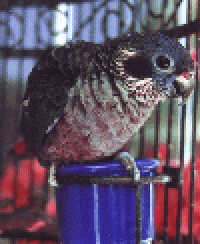
Dusky bred by Bruce & Alicia McWatters

Dusky bred by Bruce & Alicia McWatters
Special thanks to C.T.E. Partridge for much of the info on this page.
Parrots of this South American genus are slightly smaller and have darker plumage than
the amazon parrots. They are medium size with short squarish tails. They have a
distinctive notch in the upper mandible and a prominent naked cere and eye ring. All have
red under tail-coverts which stand out against their dark colouring.
There are eight species in this genus, of which five are readily available as domestic
raised pets in the US. These five are the Blue headed pionus, Bronze wing pionus, Dusky
pionus, White cap pionus and Maximillian pionus. The remaining three are the Plum crowned,
White head and Coral billed (or sordid) pionus.
From a distance, especially in artificial or bad light, they look rather drab, with the
general plumage a brownish or muddy purple color. However, once you get a good look at
these birds, you might considere them the most attractive of the pionus species. Many
people are captivated be the fact that they seem to resemble miniture hawks, or maybe a
peregrine falcon. There are a multitude of complex shadings of colors all over their
bodies. The entire front is pink and their wings when spread out show the most marvelous
shades of blue. Their beaks are mostly black with some flesh tone near the base. Their
feet are blackish gray and their eye ring is a soft charcoal gray. Unfortunately it is
very hard to find a picture that does them justice. Their marvelous colors do not
photograph well.
The average life span for a pionus is 25 years. However, there are many that live longer,
some as old as 40. Remember, the main reason that birds die young is because of either
accidents or bad nutrition! Don't let your pet become a statistic! Read as much as you can
to make your home bird friendly and bird safe, clip those wings, and follow good
nutritional practices.
Duskies are one of the smallest pionus species. They tie with the white-cap at a petite 9and 1/2 inches. Most of that size is body since they have short tails.
Undeterminable
Northern portions of South America.
They are very good pets as they are generally good natured and less highly strung and
demanding than some other birds. They are surprisingly obedient birds that will learn
simple tricks. As with any parrot always use the "up" and
"down" commands. As long as your pionus understands the rules of the house and
is raised in a very caring sensitive way, with nurturing dominance, he will be a wonderful
sweet pet. Remember, for your pionus to be wonderfully obedient he needs rules to
follow. Practice those "up" and "down" commands with him and make sure
he understands what acceptable behavior is. There are many good parrot training/behavior
books out there. Make sure you take the time to read them
Pionus parrots have a reputation for being a bit staid and sedate. They are known to
suffer from getting fat as they tend to just eat and sit on the perch if not entertained.
Because of this make sure that you provide them with a large cage and lots of toys.
Pionus are not know for their talking ability. If that is what you are looking for in a
parrot, then keep looking. With pionus, talking is highly variable between individuals. On
average, they learn to say a few words (as in under 10), but don't say them with much
clarity. Because of the high variability however, there are some individuals who speak
quite clearly and learn 20 words.
Very Quiet. Pionus parrots in general are reported to be quiet when kept as pets. Baby birds make a distinctive begging sound which sounds like a very small sheep bleating. However, even though pionus are rated as quiet birds, they can learn to screech, and can be louder than some cockatiels. On occasion you can find a pionus that screams just as loudly as a sun conure. Most pionus screaming is because of their environment and the way they are raised. A happy pionus does not have to be a screaming pionus. Then again, a pionus that screams is not necessarily unhappy.
$400-$1,000. This large range is due to regional variation and whether you buy from a breeder or pet shop. Please remember that a cheaper bird is not a better bird.
|
Updated : 10/2022
(c) 1994-2022 Grant Yoshimori